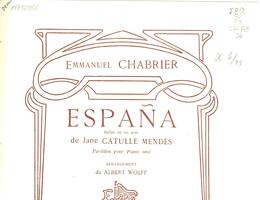España
Rhapsody for orchestra, premiered on 4 November 1883 at the Société des Nouveaux Concerts de Charles Lamoureux.
In 1880, Chabrier decided to devote himself entirely to music and left the Ministry of the Interior after twenty years of service. Two years later, he moved to Spain for a few months and developed a passion for its folk music. Captivated by the rhythmic and melodic inventiveness of this tradition, he noted and collected a multitude of themes. On his return to France, Chabrier composed his first orchestral work: España. Conceived as a rhapsody in one movement, the work is marked Allegro con fuoco. It begins with pizzicati for the violins, violas and cellos, evoking the plucking of guitar strings. With its 3/8 metre and syncopated rhythms, the character is naturally dancelike. Melodically, the work consists of two main themes taken from Spanish folk dances. The first – brilliant and cheerful – is an Aragonese jota. It is stated by the trumpets and bassoons, then taken up by the horns, the harp alone, and finally by the orchestral tutti, exploiting all the rhythmic efficiency of its main motif. The second – with its graceful, sensual curves – is inspired by the malagueña of southern Spain. In a final reprise of the head of the first theme, the trombones proudly ring out, recalling certain attitudes peculiar to flamenco. Premiered in 1883 in Paris by the Orchestre Lamoureux, España made Chabrier world famous. Manuel de Falla wrote: “No Spaniard has been able to render with such genius and truth the diversity of the jota as it is sung by Aragonese peasants.”


